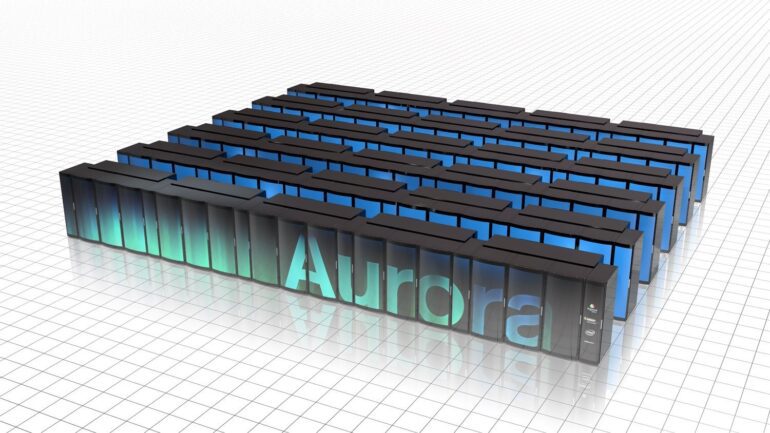TL;DR:
- Argonne National Laboratory’s Aurora exascale supercomputer is at the forefront of dark matter research.
- 15 research teams in the Aurora Early Science Program gain access to Aurora for groundbreaking experiments.
- Dark matter, constituting over five times the mass of observable matter, remains a scientific mystery.
- Aurora leverages AI and massive simulations to accelerate calculations and gain insights into dark matter behavior.
- Lattice QCD theory and machine learning are used to enhance the efficiency of dark matter research.
- Detecting dark matter is challenging due to its elusive nature and interference from ordinary matter.
- Aurora’s powerful Intel graphics processing units enable unprecedented machine learning applications in nuclear physics.
- Understanding dark matter goes beyond practical applications, driven by the curiosity to comprehend the universe.
Main AI News:
Argonne National Laboratory, under the aegis of the U.S. Department of Energy, is propelling scientific exploration into the enigmatic realm of dark matter with its groundbreaking Aurora exascale supercomputer. As one of the nation’s pioneering exascale systems, Aurora heralds a new era in computational capabilities. To harness its potential fully, 15 esteemed research teams are actively participating in the Aurora Early Science Program (ESP) facilitated by the Argonne Leadership Computing Facility (ALCF), a distinguished DOE Office of Science user facility. This initiative empowers researchers with pre-production access to Aurora, positioning them at the forefront of scientific inquiry.
Dark matter, a mysterious entity constituting over five times the mass of observable matter in the universe, remains an enigma. Despite its paramount role in the formation of galaxies and the cosmic structure, the nature of dark matter continues to elude scientific comprehension. William Detmold, a professor of physics at MIT, emphasizes the challenges posed by dark matter detection, stating, “A detector will basically just count and hopefully see some number of dark-matter interactions, but it won’t tell you about those interactions.” The term “dark” alludes to its inherent inability to reflect or emit light, rendering its detection a formidable task. Yet, it is this very darkness that exerts gravitational influence, maintaining celestial bodies’ harmonious orbits.
Argonne’s Aurora exascale supercomputer, a collaborative endeavor with Intel and Hewlett Packard Enterprise, will emerge as one of the world’s most formidable supercomputers, dedicated to open science. Within this innovative platform, Professor Detmold and his colleague, Professor Phiala Shanahan of MIT, are poised to revolutionize the realm of dark matter research by leveraging artificial intelligence (AI) and conducting massive simulations. Exascale computing, capable of performing a staggering one exaflop or a billion billion calculations per second, will catapult their investigations into uncharted territories.
The Aurora ESP project, led by Detmold and Shanahan, focuses on advancing the long-established physics theory known as Lattice QCD (quantum chromodynamics) into the exascale era. This ambitious endeavor confronts the challenge of observing the presently unobservable by employing exascale computing power and AI to expedite the process of calculating expected responses in laboratory experiments. Their specific objective involves employing machine learning to enhance the efficiency of sampling gluon field configurations within the mathematical framework of Lattice QCD, thereby accelerating calculations and providing invaluable insights into particle interactions and fundamental physics phenomena relevant to the study of dark matter.
Dark matter, a concealed entity distinct from protons, electrons, and other particles described by the Standard Model of physics, remains an elusive puzzle. As Detmold elucidates, “Our team’s research is based on the theory of quantum chromodynamics, which explains the way quarks interact with one another inside the nucleus of an atom.” It is this intricate understanding that forms the foundation for unraveling potential interactions with dark matter.
Detecting dark matter presents a formidable challenge. The crux lies not only in its identification but in the meticulous elimination of background interactions with ordinary matter. It’s a task akin to finding a needle in a haystack, complicated by extraneous radiation. While some experimentalists seek refuge deep underground, shielded from all forms of radiation, computational physicists pursue a distinct path. As Detmold affirms, “A detector will basically just count and hopefully see some number of dark matter interactions, but it won’t tell you about those interactions.” The true quest lies in deciphering the nature of dark matter from these detections.
Lattice QCD, a well-established concept, has undergone extensive computation on powerful supercomputers for years. Detmold and Shanahan, active members of the U.S. Lattice Quantum Chromodynamics (USQCD) Collaboration, have diligently prepared for the exascale era, with Lattice QCD research demanding substantial computational resources. Aurora, with its formidable Intel graphics processing units, is poised to enable the deployment of custom machine learning architectures developed for physics on an unprecedented scale. This represents a significant leap in nuclear physics calculations, pushing the boundaries of traditional approaches.
The pursuit of understanding dark matter transcends its practical applications, as Detmold aptly concludes, “Basic curiosity is driving what we do. Understanding how nature works for the sake of understanding it is important.” The mysteries of the universe, deeply intertwined with dark matter, beckon scientists to unravel their secrets, and Argonne’s Aurora exascale supercomputer stands as a formidable tool in this quest for knowledge.
Conclusion:
Argonne’s Aurora Supercomputer represents a significant leap in dark matter research, offering a powerful tool to unravel the mysteries of the universe. This technological advancement holds the potential to drive innovation in the field of nuclear physics and broaden our understanding of fundamental science, impacting related markets and industries.

